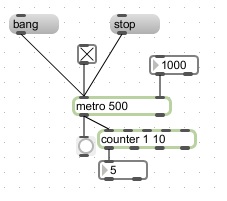I’ve been playing with different tunings recently, inspired by a SuperCollider patch written by Travis Weller and Dave Benson’s book Music: A Mathematical Offering and Kyle Gann’s Anatomy of an Octave. I built my own little MaxMSP patch to demonstrate the Pythagorean comma. It transposes an oscillator up by 12 perfect fifths and then back down by 7 octaves. The resulting pitch is just slightly higher than the fundamental, a difference of 1.01364… called the Pythagorean comma or the ditonic comma. Fascinating stuff–and tracing the way tunings were pushed about until our prevalent equal tempered system took over illuminates an alternate history of Western music. (Another topic, for later…)
Playing with this stuff makes me wonder how the ancient Greeks figured it out way back in 500 BC. The way I imagine it, physically performing this experiment would require at least 3 strings (1 tuned to the fundamental, 1 tuned to the current target interval, 1 to be tuned to the next target interval) and plenty of retuning. Or maybe it was more like a lyre with 20 strings and plenty of time spent tuning each. In any case, the comma is so small that after tuning so many intervals, I’d be more inclined to explain away a tiny difference as something slipping, the instrument flexing, cumulative errors during the process, etc. But maybe that’s just the banjo player in me…
The answer to my question is likely: they did the math. It ain’t called the Pythagorean comma for nothin’.
Here’s the math:
1/1 (fundamental) up a perfect fifth (1) =
3/2 up a perfect fifth (2) =
9/4 up a perfect fifth (3) =
27/8 up a perfect fifth (4)=
81/16 up a perfect fifth (5)=
243/32 up a perfect fifth (6)=
729/64 up a perfect fifth (7)=
2187/128 up a perfect fifth (8) =
6561/256 up a perfect fifth (9)=
19683/512 up a perfect fifth (10)=
59049/1024 up a perfect fifth (11)=
177147/2048 up a perfect fifth (12)=
531441/4096 down an octave (1) =
531441/8192 down an octave (2) =
531441/16384 down an octave (3) =
531441/32768 down an octave (4) =
531441/65536 down an octave (5) =
531441/131072 down an octave (6) =
531441/262144 down an octave (7) =
531441/524288 = 1.013643264771 = the pythagorean comma

